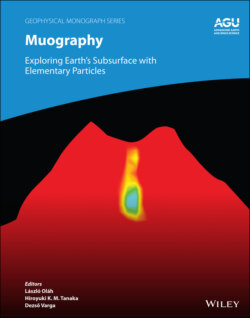Читать книгу Muography - Группа авторов - Страница 52
3.5 DENSITY BIAS
ОглавлениеRosas‐Carbajal et al. (2017) increased the quantity of dataset significantly, with muography data taken from three directions and more than a hundred gravity data on La Soufrière de Guadeloupe lava dome (Lesser Antilles). They performed a linear inversion, taking a formulation similar to equation 3.9 but with a different approach for regularization. The reconstructed three‐dimensional density profile (Gibert et al., 2021) presents a low‐density region located below the southern part of the lava dome near the summit. The position of this low density corresponds to most presently active fumaroles on the dome. Considering that the electrical conductivity model poses a conductive region there, they conclude that the region is porous and highly altered due to the presence of thermal fluids. In this region of the lava dome, a temporal variation of muon flux associated with hydrothermal activities was also observed (Jourde et al., 2016).
Contrary to the success of 3D imaging, Rosas‐Carbajal et al. (2017) point out a non‐negligible offset between the density estimated from muography and that from gravity. In the case of La Soufrière de Guadeloupe lava dome, such offset amounts to 0.47 g/cm3. Specifically, muography tends to yield lower density compared to the apparent density estimated from gravity data. In other words, muography detectors placed on the mountain slope perceive flux higher than expected. As an immediate solution, Rosas‐Carbajal et al. (2017) propose to separate the density sensed by gravity data ( ρ g ) and the density sensed by muography data ( ρ μ ) and relate the two vectors with an unknown constant bias (Δρ), written as ρ g = ρ μ + (Δρ, Δρ, ⋯, Δρ)T. This constant density bias is solved together with ρ μ . Lelièvre et al. (2019) derived a comprehensive formulation for estimating this sort of constant density bias.
